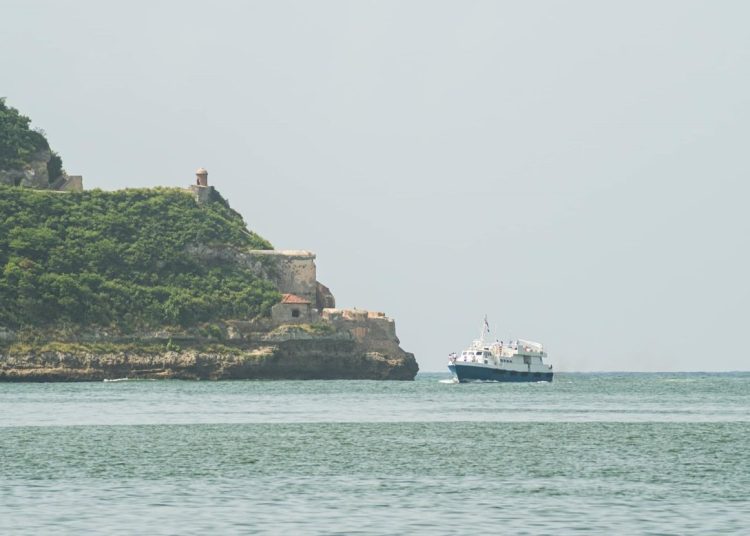Experts suppose that the amphorae found at the site contain ashes of deceased persons, or were depositories of these before being thrown into the sea as an act of last will.
by OnCuba Staff
December 27, 2023

Dozens of amphorae, as well as cannons from the colonial period, boxes with bullets from artillery pieces and other implements of war lie at the site of the discovery, at a depth of about 10 meters, in the eastern part of the entrance to Santiago's bay.
Photo: Naturaleza Secreta/Facebook
Researchers from the Regional Center for Management and Handling of the Underwater Natural and Cultural Heritage (CUBASUB) discovered by chance a submerged “cemetery” in the vicinity of Castillo del Morro San Pedro de la Roca, in the city of Santiago de Cuba.
In the place of the discovery, about 10 meters deep, in the eastern zone of the entrance of the bay of Santiago, lie dozens of amphorae, as well as cannons from the colonial period, boxes with bullets from artillery pieces, and other implements of war, according to an article published by the provincial newspaper Sierra Maestra.
Experts suppose that the amphorae found contain ashes of deceased people, or were depositories of these before being thrown into the sea as an act of last will.
The peculiar cemetery appeared while the researchers were carrying out prospecting work linked to the search and location of an old submarine cable used for almost a century for telecommunications, and that in the territory had been baptized as “the English cable”.
Researchers from the Regional Center for Management and Handling of the Underwater Natural and Cultural Heritage (CUBASUB) discovered by chance a submerged “cemetery” in the vicinity of Castillo del Morro San Pedro de la Roca, in the city of Santiago de Cuba.
In the place of the discovery, about 10 meters deep, in the eastern zone of the entrance of the bay of Santiago, lie dozens of amphorae, as well as cannons from the colonial period, boxes with bullets from artillery pieces, and other implements of war, according to an article published by the provincial newspaper Sierra Maestra.
Experts suppose that the amphorae found contain ashes of deceased people, or were depositories of these before being thrown into the sea as an act of last will.
The peculiar cemetery appeared while the researchers were carrying out prospecting work linked to the search and location of an old submarine cable used for almost a century for telecommunications, and that in the territory had been baptized as “the English cable”.
The publication specifies that from historical documents it can be established that the site was used by the Spanish military that occupied the Santiago fortress to take to it, employing a system of cables and manual machinery, diverse supplies used by the garrison.
The experts point out as hypothesis of the presence of the artillery pieces that some of them accidentally fell silent at the moment of their transfer and since then they remained in the seabed of the place used later by the relatives of the deceased to throw their ashes.
“There is nothing mysterious about this practice, nor was it done secretly, only that in truth very few knew that so many deceased made ashes would end up in the sea and in such a strategic place as the ‘mouth of the bay’, and exactly under the emblematic Castillo del Morro”, highlights the media.
The castle and the cable
The Morro San Pedro de la Roca Castle, declared a World Heritage Site by UNESCO, was part of the defensive system of the city of Santiago de Cuba in colonial times, along with the forts and batteries of La Estrella, La Socapa, Santa Catalina.
As a result of the investigations carried out, plans, maps, engravings, photos and all kinds of documentation have been compiled for study, but some issues “come to the patrimonial scene many years later,” says the article by Dr. Jesus Vicente Gonzalez, reviewed by Sierra Maestra.
Some evidence found points to a certain relationship with the place where the so-called “English cable” passed, which by the end of the 19th century was the latest in communications.
It was managed by the British company The Cuba Submarine Telegraph Company LTD, established on the island since the second half of that century when a cable was laid from Batabanó to Cienfuegos and from there to Manzanillo.
Another route linked the Pearl of the South with Santiago de Cuba and continued to Haiti and Jamaica to link from these countries with other places on the planet, the text notes.
It adds that during the Spanish-Cuban-American war of 1898, the U.S. Navy cut the cable. It was later restored and with obsolete equipment, it remained in operation until 1975.
No comments:
Post a Comment